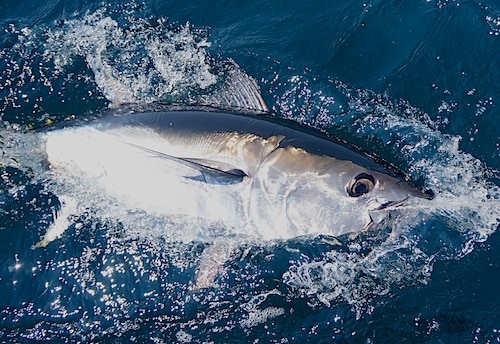
Bluefin Tuna 1
You’d have to have been living under a rock to not know that Atlantic bluefin tuna have been in serious trouble for some time now — regardless of what you may see on Wicked Tuna. As I write this, longlining is still allowed in the Gulf of Mexico, the only known spawning ground for western Atlantic bluefin. And while the U.S. longline fleet cannot target bluefin in the Gulf, it still represents over 100 metric tons of tuna killed each year. All of these fish that are caught in the Gulf of Mexico are there because they are spawning — or at least trying to.
But there are other species of bluefin that warrant your attention. That’s right, some may be surprised to hear that there are not one, but three recognized species of bluefin tuna swimming the earth’s seas: Atlantic bluefin (Thunnus thynnus), Pacific bluefin (Thunnus orientalis) and southern bluefin (Thunnus maccoyii). How are these other two species faring? Surprise, surprise, not too great.
As their name suggests, southern bluefin tuna are found only in the southern hemisphere and are the smallest of the three species. The species doesn’t get the press its Atlantic counterpart does but its situation is just as bad, if not worse. Heavily fished since the 1950s, this tasty Down Under tuna has declined by an estimate 85 percent in the last thirty years. Indeed, if the current exploitation continues, it is estimated that the population will be below 500 mature individuals in 100 years. As such, the International Union for the Conservations of Nature has listed them as critically endangered.
However, the real shocker came early this year when the International Scientific Committee for Tuna and Tuna-Like Species in the North Pacific Ocean released the most current stock assessment for Pacific bluefin tuna. According to the latest data, decades of overfishing has caused the Pacific bluefin population to decline by an estimated 96.4 percent! How could this have happened? Well, it doesn’t help that more than 90 percent of Pacific bluefin tuna that are harvested are juveniles that have not had the opportunity to spawn even once. Exacerbating this is the fact that countries are fishing in the only known spawning and nursery areas for this species (sound familiar?).
Bluefin tuna don’t have a lot going for them that make them good candidates for overfishing. Besides being large, delicious species that fetch incomprehensible market prices, they are also long lived (20 to 40 years), slow to reach reproductive maturity (upwards of 12 years) and reproduce in geographically restricted spawning sites for short periods of one or two months. In short, these fish desperately need a break. As anglers, support stronger international conservation measures, alternative fishing gear and the protection of spawning areas. And for Pete’s sake, next time you’re at your neighborhood sushi joint think about passing on the otoro.







